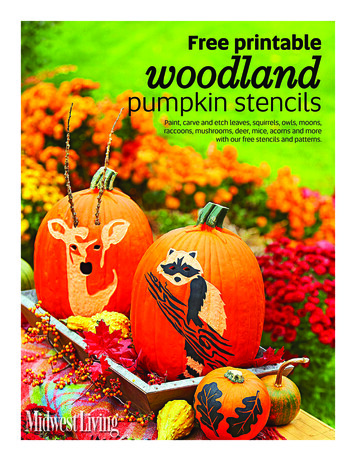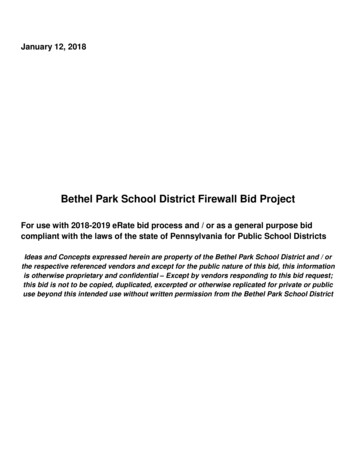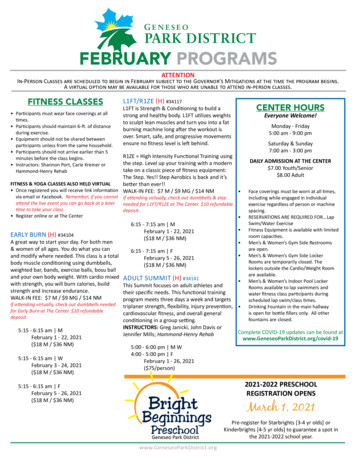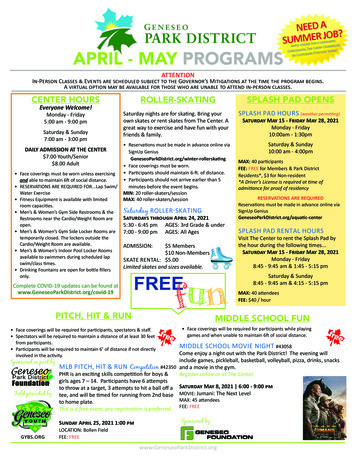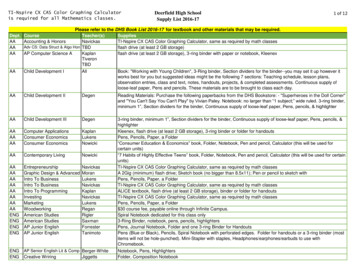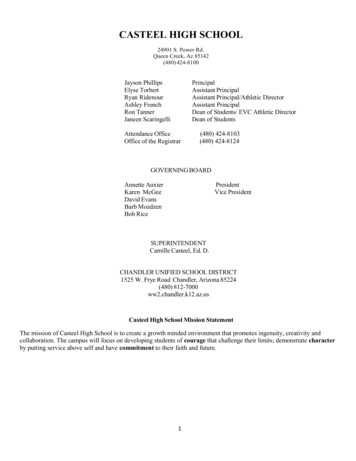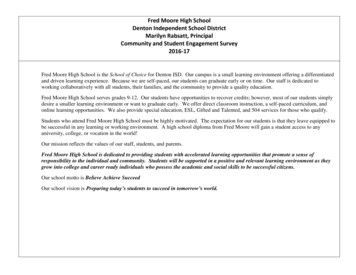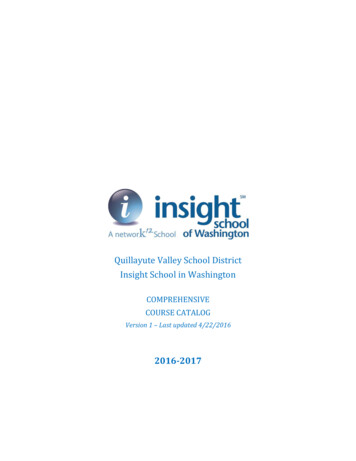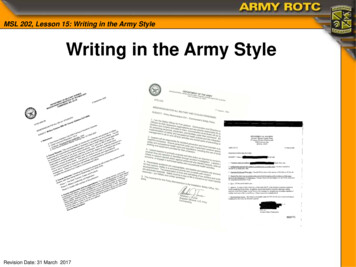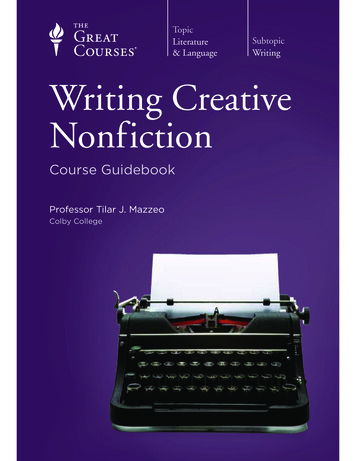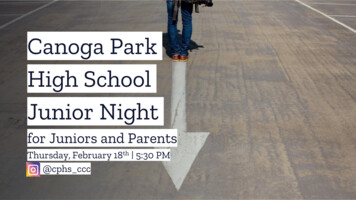
Transcription
Woodland Park School DistrictWriting CurriculumEnglish Language ArtsCurriculum Writers: Elisabetta Macchiavello, Nancy Munro, Lisa Healey-Wilk,Samantha Krasnomowitz, Monica Voinov, Michele Skrbic, Krystal Capo, Nicole Webb,Veronica Seavy, Pamela Yesenosky, Steve Sans, Rosemary Ficcara, Laura Masefield,Meghan Glenn2016-2017Carmela TrigliaDirector of Curriculum and Instruction
ContentsK-8 Curriculum Map . 4Kindergarten Writing Curriculum . 5Unit Title: Building a Talking Community: Oral Language . 6Unit 1: Launch Writing . 8Unit 2: Writers are Readers . 11Unit 3: How-To Books . 13Unit 4: Persuasive Writing . 15First Grade Writing Curriculum . 17Unit 1 Title: Launching/ Small Moments (Narrative) . 19Unit 2: How-To Writing . 22Unit 3: Writing Non-Fiction (Information) . 24Unit 4: Opinion Writing . 27Unit 5: Realistic Fiction . 30Unit 5: Poetry . 33Second Grade Writing Curriculum . 35Unit Title: Narrative Writing/Small Moments . 36Unit Title: Writing About Reading . 41Unit Title: Lab Reports and Science Books. 46Unit Title: Poetry . 51Third Grade Writing Curriculum . 56Unit Title: Routines: Launching the Writing Workshop . 57Unit Title: Unit 1 Crafting True Stories. 59Unit Title: Unit 2: The Art of Information Writing . 61Unit Title: Unit 3 Changing the World . 64Unit Title: Unit 4 Once Upon a Time . 66Unit Title: Unit 5 Poetry . 681
Fourth Grade Writing Curriculum . 71Unit Title: Routines: Launching the Writing Workshop . 72Unit Title: Unit 1: Arc of Story . 74Unit Title: Unit 2: Boxes and Bullets: Personal and Persuasive . 76Unit Title: Unit 3: Bringing History to Life . 78Unit Title: Unit 4: Literary Essay: Fiction Writing . 81Unit Title: Unit 5: Journalism and Opinion Writing: Myths, Folklore and Tall Tales . 83Unit Title: Unit 6: Poetry . 86Grade Five Writing Curriculum . 88Unit Title: Narrative Fan Fiction: Writing Inspired by our Favorite Stories . 89Unit Title: Informational Writing - Nonfiction Picture Books . 93Unit Title: Research Based Argument Essay . 97Unit Title: Speeches - Career and Innovation Speeches . 102Unit Title: Fantasy . 106Grade Six Writing Curriculum . 110Unit Title: Narrative Realistic Fiction - Creating Believable Characters . 111Unit Title: Argument - The Literary Essay . 115Unit Title: Informational Text - Teaching Books . 120Unit Title: Biography - Writing about Influential People (Mixed Genre) . 124Unit Title: Poetry . 128Seventh Grade Writing Curriculum . 131Unit Title: Narrative: Realistic Fiction: Symbolism, Syntax and Truth . 132Unit Title: Journalism: Uncovering the Stories of Our World . 136Unit Title: The Art of Argument . 141Unit Title: Poetry - Self Portraits . 144Unit Title: Cross Genre: Developing Writing Styles and Craft through Social Issues . 146Eighth Grade Writing Curriculum. 1482
Unit Title: Narrative Realistic Fiction - Realistic Fiction: Using Story Elements to Convey Ideas . 149Unit Title: Argument Writing . 151Unit Title: Informational Writing - Historical Perspective . 153Unit Title: Memoir - Sharing our Story . 1563
K-8 Curriculum MarchAprilMayJuneKBuilding a TalkingCommunityLaunch WritingLaunch WritingWriters areReadersWriters areReadersHow-To BooksHow-To riting1Launch/SmallMomentsHow-To WritingHow-To WritingWriting NonFictionWriting NonFictionOpinion WritingWriting AboutReadingLab Reports andScience BooksLab Reports andScience BooksLaunch/SmallMomentsOpinion WritingRealistic FictionHow-To Writing2Narrative WritingNarrative WritingWriting AboutReadingWriting AboutReadingRealistic FictionRealistic FictionLab Reports andScience BooksPoetryPoetryIf.Then Poetry3RoutinesCrafting TrueStoriesCrafting TrueStoriesThe Art ofInformationWritingThe Art ofInformationWritingChanging TheWorldChanging theWorldOnce Upon aTimeOnce Upon aTimePoetryPersonal/PersuasiveBringing Historyto LifeBringing Historyto LifeLiterary EssayFictionLiterary EssayFictionMythology/Folk LoreMythology/Folk lWritingInformationalWritingResearch BasedArgument EssayResearch BasedArgument EssayCareer SpeechesFantasyFantasyArc of Story4Routines5Launch/Fan FavoritesArc of StoryFan search BasedArgument EssayCareer SpeechesBiography6NarrativeRealistic FictionNarrativeRealistic FictionArgumentLiterary EssayArgument –Literary EssayArgument –Literary EssayTeaching Books7Launch/Realistic FictionRealistic entPoetrySocial IssuesSocial IssuesRealistic moirPoetry8Realistic FictionTeaching BooksBiographyPoetryPoetry4
Kindergarten Writing CurriculumPacing GuideContent Area: Writing-Language ArtsGrade Level: KindergartenBuilding a Talking Community: Oral LanguageUnit 1: Launch WritingUnit 2: Writers are ReadersUnit 3: How-To BooksUnit 4: Persuasive bruary-MarchApril-June5
Unit Title: Building a Talking Community: Oral LanguageGrade Level: KindergartenTime Frame: SeptemberStandards: W.K.3, W.K.8 SL.K.1 SL.K.2 SL.K.3 SL.K.4 SL.K.6 L.K.1, RF.K.1, L.K.1B, L.K.2.C, L.K.4, L.K.6Essential Questions:Unit Goals/Enduring Understandings: How do writers become a community of writers? Writers work together to become a community. How do writers think and choose a topic? Writers learn how to choose a topic. How do writers recite their stories? Writers recite their stories to an audience.Skills:Demonstration of Learning: Partner share Speaking Informal-Formal assessment/notes-checklist Story teller/Story telling Listening Writing charts/routines Community Rehearsal Oral language Audience ConferringMentor Texts:Resources:Structures:Writing Process K-2Too Many Toys by David Shannon**refer to “Writing Pathways K-5/ A Minilessons Generate Ideas (Think)TitchGuide To The Common Core Writing Independent Writing Rehearse (Say)I Love SchoolWorkshop/A Guide To The Common Interactive Writing (K-1 only) Plan (Sketch)When I get BiggerCore Writing Workshop by Lucy Conferencing DraftCalkins * Shared Writing/Reading ReviseMastering Mechanics Guidebook Strategy Groups Partner Editwww.readingandwritingproject.comConversations PublishAssessment Tools Mid-Workshop Teaching Point CelebrateRead aloud Teaching ShareAnchor charts Quiet space to calm down/relaxModifications/Accommodations:Cross Curricular Connections:21st Century Themes Preferential seating Small group/One to oneSocial Studies- Communities, RulesGlobal Awareness Reduction of distractionsst Large print textbooksand Laws21 Century Skills Hands-on activities Additional timeHealth- Social Emotional SkillsLearning and Innovation Skills Follow a routine/scheduleScienceCritical Thinking and Problem Solving Review of directions Alternate quiet and active time Student restates informationCommunication and Collaboration Teach time management skills Studentprovidesoralresponses Rest breaksLife and Career Skills Concrete examples Verbal and visual cues regardingSocial and Cross-Cultural Skills Support auditory presentations withvisuals Assistance in maintaining unclutteredspace Space for movement or breaksExtra visual and verbal cues and prompts directions and staying on taskChecklistsImmediate feedbackWork-in-progress checkPersonalized examplesBooks on tape6
Unit Title: Building a Talking Community: Oral LanguageGoals1. Writers worktogether to becomea community.Grade Level: KindergartenSuggested Mini lessons Writers will learn how to follow routines and procedures on the carpet.(May span up to a week.) *Infuse Morning Message on chart paperWriters tell a story about things they know how to do.Writers learn how to use a “speaking voice” and look at audience whentalking about things they know how to do.Writers actively listen to others when telling about things they know howto do.Writers take turns being both a listener and speaker. (Spans over 2 days)Writers listen and learn how to respond to the speaker.2. Writers learn how tochoose a topic. Writers use experiences to generate ideas.Writers share meaningful experiences.Writers think, share, and rehearse to self.3. Writers recite theirstories to anaudience. Writers think, picture, and say their story. Time Frame: SeptemberTeacher’s Notes/Ideas*Refer to Mentor texts*Anchor charts*Set classroom writingroutine*refer to MasteringMechanics pg40-60-70-132*Trade book: Titch, I LoveSchool, When I Get Bigger*Anchor charts*Anchor charts (thinkpicture-say )7
Unit 1: Launch WritingGrade Level: KindergartenStandards: W.K.3 W.K.5 SL.K.1 SL.K.3 SL.K.4 SL.K.5 L.K.2Essential Questions: How do writers learn to write? How do writers add more pages to their story? How do writers tell a story before writing? How do writers publish?Skills: Edit Publish Routines/procedures Writing process Rehearsal (partners-audience)Mentor Texts:Resources:Freight Train*Unit 1-Launching the Writing WorkshopCreak! Said the Bedby Lucy Calkins* “Writing Pathways K-5/ A Guide To TheCommon Core Writing Workshop/AGuide To The Common Core WritingWorkshop by Lucy Calkins *CD-ROM “Resources for Teaching WritingAnchor chartsPost-itsPens-paper-date stamper*(Writing Tools)Cross Curricular Connections:21st Century ThemesSocial Studies- Communities, RulesGlobal Awarenessand Laws21st Century SkillsHealth- Social Emotional SkillsLearning and Innovation SkillsScienceCritical Thinking and Problem SolvingCommunication and CollaborationLife and Career SkillsSocial and Cross-Cultural SkillsTime Frame: October-NovemberUnit Goals/Enduring Understandings: Writers learn how to write a story. Writers add more pages to story. Writers tell a story. Writers prepare for publication.Demonstration of Learning: Assessment/checklist-notes Conferring Writing foldersStructures: Minilessons Independent Writing Interactive Writing (K-1 only) Conferencing Shared Writing/Reading Strategy Groups PartnerConversations Mid-Workshop Teaching Point Teaching ShareModifications/Accommodations: Small group/One to one Large print textbooks Additional time Review of directions Student restates information Student provides oral responses Concrete examples Support auditory presentations with visuals Assistance in maintaining uncluttered space Space for movement or breaks Extra visual and verbal cues and prompts Personalized examples Books on tapeWriting Process K-2 Generate Ideas (Think) Rehearse (Say) Plan (Sketch) Draft Revise Edit Publish Celebrate Quiet space to calm down/relaxPreferential seatingReduction of distractionsHands-on activitiesFollow a routine/scheduleAlternate quiet and active timeTeach time management skillsRest breaksVerbal and visual cues regardingdirections and staying on taskChecklistsImmediate feedbackWork-in-progress check8
Unit 1: Launch WritingGrade Level: KindergartenTime Frame: October-NovemberGoalsSuggested Mini lessonsTeacher’s Notes/Ideas Writers learn how towrite a story. Writers add morepages to story. Writers put ideas on paper with pictures and words. We thinkabout what we know and want to tell other people.Writers look back and add more. Writers “Revise”Writers solve unknowns in writing procedures. Writers think tothemselves, if there is something I don’t know I can figure out away to solve it on my own. WE realize we are the boss of ourown writing and make the choice not to waste any time.Writers sketch their stories with details. We think about thestory we want to tell and imagine the details in our heard. Wethen turn the picture in our minds into words or pictures onpaper.Writers stretch out words slowly and write the sounds we hear.Writers try their best even when it is difficult and never give up.*Anchor charts*Model sample*Anchor Charts “When We Are Done, WeHave Just Begun”*Stretchy the SnakeWriters add more pages when they want to teach more aboutwhat they are writing. We can turn our pages into a book bystapling each page together.Writers plan and write a whole book.Writing partners can help us add to our work. When we sharewhat we wrote, our partners may have questions. We can thenadd to what we wrote to help answer those questions and thenteach even more about our topic.Writers stretch out words to write all the sounds. Writers alsouse words stuck in our memory to help with writing our stories(sight words)Writers recall what strategies good writers use in order to writeand add more details without wasting time. We may talk withour partners and keep a checklist of things we can do to makeour writing the best it can be.*Partnership chart/Anchor chart*I Can Revise MY Teaching /Anchor charts*pg. 54 figures for writing*Refer to “Coaching” pg61*Word wall/Student name chart*Information writing checklist pg839
Writers tell a story. *Anchor Charts pg. 94 Writers get ready to write by first telling their stories. We use asmuch details in our stories including what other people said anddid.Writers plan stories page by page to show that good storiesbuild up slowly. Each time there is a new part to our story weturn the page.Writers add details to stories. (Who-What-Where)Writers recall how to stretch sounds in words.Writers use speech bubbles.Writers proofread. Writers reread and rewrite work.Writers celebrate published stories.*Anchor Charts-Model work Writers prepare forpublication.*Narrative Checklist (CD-ROM) pg. 131*Anchor Charts “How to Write a TrueStory” pg12910
Unit 2: Writers are ReadersGrade Level: KindergartenTime Frame: December-JanuaryStandards: W.K.3 W.K.5 W.K.6 W.K.7 RFS.K.1 RFS.K.2 RFS.K.3 RFS.K.4 SL.K.1 SL.K.2 SL.K.3 SL.K.4 SL.K.5 SL.K.6 L.K.1 L.K.2 L.K.4Essential Questions:Unit Goals/Enduring Understandings: How do writers read their stories? Writers learn how to read their own work. How do writers use tools? Writers use tools. How do writers make stories fun? Writers make stories fun to read. How do writers get ready for publication? Writers prepare to publish.Skills:Demonstration of Learning: Rehearsal (partners-audience) Edit Assessment/notes-checklist Illustrations Publish Use of strategies Getting topics Routines/procedures Conferring-group work Texts Writing process Writing work in foldersMentor Texts:Resources:Structures:Writing Process K-2Shortcut by Donald Crews*Unit 2-Writing For Readers * Lucy Minilessons Generate Ideas (Think)A Day with Daddy by NikkyCalkins Independent Writing Rehearse (Say)Grimes* Writing Pathways K-5/ A Guide To The Interactive Writing (K-1 only) Plan (Sketch)The Snowy Day by Ezr Jack KeatsCommon Core Writing Workshop/A Conferencing DraftDon’t let the Pigeon Drive the Bus Guide To The Common Core Writing Shared Writing/Reading Reviseby Mo WillemsWorkshop by Lucy Calkins * Strategy Groups Partner EditA Chair for My Mother by Vera B.Conversations PublishWilliamsCD-ROM Teaching Writing Mid-Workshop Teaching Point CelebrateOwl Moon by Jane YolenAnchor charts Teaching ShareWhen Sophie Get Angry ReallyPost-itsReally Angry by Molly BangPens-paper-date stamper*(Writing Tools)Cross Curricular Connections:21st Century ThemesModifications/Accommodations: Quiet space to calm down/relaxSocial Studies- Communities,Global Awareness Small group/One to one Preferential seatingRules and Laws21st Century Skills Large print textbooks Reduction of distractionsHealth- Social Emotional SkillsLearning and Innovation Skills Additional time Hands-on activitiesScienceCritical Thinking and Problem Solving Review of directions Follow a routine/scheduleCommunication and Collaboration Student restates information Alternate quiet and active timeLife and Career Skills Student provides oral responses Teach time management skillsSocial and Cross-Cultural Skills Concrete examples Rest breaks Support auditory presentations with Verbal and visual cues regardingvisualsdirections and staying on task Assistance in maintaining uncluttered Checklistsspace Immediate feedback Space for movement or breaks Work-in-progress checkExtra visual and verbal cues and prompts Personalized examples Books on tape11
Unit 2: Writers are ReadersGoals1. Writers learn how toread their own work.Grade Level: KindergartenSuggested Mini lessons Time Frame: December-JanuaryTeacher’s Notes/Ideas*Anchor charts Writers reread our stories. If we have trouble getting through it, we fix it upso that others don’t have the same problem.Writers write personal stories using what they have learned.Writers share work and draw to tell their story.Writers write sentences that match pictures. (Use of punctuation in speechbubbles)Writers reread often.2. Writers use tools. Writers use a checklist.Writers use vowels to help with middle sounds in writing. (Use chart)Writers use “snap” words/word wall.Writers use story telling words. (First/Next/Last &-use descriptive words)Writers use partners as tools. (Turn and Talk)Writers engage with partners to clarify and edit work.Writers reflect on work to make it readable. (Guided Inquiry Lesson)* Narrative Writing Checklist & vowelchart on CD-ROM*Anchor Charts*Word Wall (High Frequency Words)*Teach children to use periods3. Writers make stories funto read. Writers visualize and sketch to make stories better.Writers use tools to make writing better.Writers refer to mentor texts to write strong beginnings.Writers work with partners to revise work.*Model Revision Strategy*Use writing “Revision Flaps”*Writing for Readers Unit2-Fig. 15-1pg127 (Storytelling Transitions) *refer to chart on pg24*refer to chart pg. 32 “What MakesReading Hard To Read”*refer to Pigeon Books for speechbubbles*refer to chart pg. 45 “What MakesWriting Easy To Read”* A Chair for My Mother by Vera B.WilliamsOwl Moon by Jane Yolen*Student Conferring Centers4. Writers prepare topublish. Writers prepare for celebration.Writers use “feeling” words to write a strong ending.Writers make their stories beautiful. (Add color, check words, be neat)Writers celebrate.*Anchor Charts/ Edit tools*Anchor chart about feelings*Sophie gets Angry .by Molly Bang12
Unit 3: How-To BooksGrade Level: KindergartenTime Frame: February-MarchStandards: W.K.2 W.K.5 W.K.6 W.K.7 W.K.8 RI.K.1 RI.K.2 RI.K.3 RF.K.1 RF.K.2 RF.K.3 SL.K.1 SL.K.2 SL.K.3 SL.K.4 SL.K.5 SL.K.6 L.K.1 L.K.2 L.K.5 L.K.6Essential Questions:Unit Goals/Enduring Understandings: How do writers use text to create How-To topics? Writers use text to write How-To stories. Why do we revisit and revise our work? Writers revise and revisit writing. Why should we keep the reader in mind when writing? Writers keep readers in mind while writing. How do writers prepare for publication? Writers publish work.Skills:Demonstration of Learning: Revise-Revisit Informational Assessment/notes-checklist Turn and talk Procedures Use of strategies Tone Sequence Conferring-group work Text Features Writing work in foldersMentor Texts:Resources:Structures:Writing Process K-2Choice of “How-to” books*Unit 3-How-To Books * Lucy Calkins Minilessons Generate Ideas (Think)My First Soccer Game (in Unit* Writing Pathways K-5/ A Guide To The Independent Writing Rehearse (Say)of Study)Common Core Writing Workshop/A Interactive Writing (K-1 only) Plan (Sketch)Guide To The Common Core Writing Conferencing DraftWorkshop by Lucy Calkins * Shared Writing/Reading Revisewww.arthubforkids.com Strategy Groups Partner EditCD-ROM Teaching WritingConversations PublishAnchor charts Mid-Workshop Teaching Point CelebratePost-its Teaching SharePens-paper-date stamper*(Writing Tools)Cross Curricular Connections:21st Century ThemesModifications/Accommodations: Quiet space to calm down/relaxSocial Studies- Communities,Global Awareness Small group/One to one Preferential seatingRules and Laws21st Century Skills Large print textbooks Reduction of distractionsHealth- Social Emotional SkillsLearning and Innovation Skills Additional time Hands-on activitiesScienceCritical Thinking and Problem Solving Review of directions Follow a routine/scheduleCommunication and Collaboration Student restates information Alternate quiet and active timeLife and Career Skills Student provides oral responses Teach time management skillsSocial and Cross-Cultural Skills Concrete examples Rest breaks Support auditory presentations with Verbal and visual cues regardingvisualsdirections and staying on task Assistance in maintaining uncluttered Checklistsspace Immediate feedback Space for movement or breaks Work-in-progress check Extra visual and verbal cues and prompts Books on Tape Personalized examples13
Unit 3: How-To BooksGoalsGrade Level: KindergartenTime Frame: February-MarchSuggested Mini lessonsTeacher’s Notes/Ideas1. Writers use text
7 Unit Title: Building a Talking Community: Oral Language Grade Level: Kindergarten Time Frame: September Goals Suggested Mini lessons Teacher’s Notes/Ideas 1. Writers work together to become a community. Writers will l
